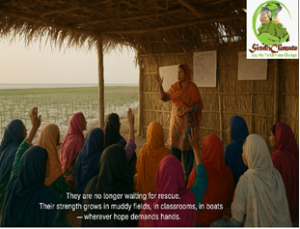
Tide of Resilience: How Coastal Women Are Leading Sindh’s Climate Survival
By Muskan Rehman
Keti Bunder, Sindh — At dawn, the tide rolls in quietly, but for women like Aroosa, it’s the sound of both loss and defiance. With her feet buried in the thick mangrove mud, she plants a new sapling — one of thousands now shielding her coastal village from the sea’s slow invasion. “These trees are our walls,” she says. “When the water comes, they stand for us.”
Across Sindh’s deltaic belt — from Keti Bunder to Kharo Chan and Jati — women are rewriting the story of climate survival. For decades, they’ve watched homes sink, soil turn saline, and livelihoods vanish as seawater crept inland. More than 1.2 million acres of fertile land have been lost to sea intrusion in the Indus Delta over the past two decades, eroding both the land and identity of coastal communities. Yet where despair once took root, resilience now blossoms.
Salma, a fisherwoman from Kharo Chan, now leads a group of widows who mend nets and manage small boats, defying social taboos that once kept them onshore.
“The sea gives less now,” she says, “but we share what it leaves.”
Nearby in Sujawal, Rukhsana, a community health worker, wades through waist-high water to check on mothers and children suffering from waterborne illnesses. Many health clinics in the region have disappeared after repeated floods and migration — leaving women like Rukhsana to fill the gap.
“When the floods cut us off, we rely on each other,” she explains. “We’ve learned to be our own first responders.”
These women are not alone. Supported by local groups like the Pakistan Fisherfolk Forum and global partners under the Sindh Coastal Resilience Project (SCRP) — a Government of Sindh initiative backed by the World Bank — they are rebuilding mangrove forests, setting up early warning systems, and training young girls in disaster preparedness.
Since 2021, the SCRP has helped restore over 15,000 hectares of mangrove forests and engaged more than 2,000 coastal women in eco-restoration and climate adaptation activities. In Rehri Goth, Nida, a teacher, uses her classroom as a hub of hope.
“Every child learns how to read the sky, track the tides, and stay safe when floods come,” she says proudly.
Her student, Shazia, 14, adds, “Before, we were afraid when the rain came. Now we know what to do — we know we can help.”
Women in the delta also draw on traditional ecological knowledge — watching moon cycles, mangrove flowering patterns, and wind directions to predict tides and fish movements. This ancestral wisdom, passed from mothers to daughters, now merges with modern training to build community resilience.
According to Mr. Mehran Ali Shah Chairman Pakistan Fisherfolk Forum, “The leadership of coastal women has transformed our climate response. Their knowledge, discipline, and courage are the backbone of every resilience effort along Sindh’s coast.”
Older residents recall a coastline once lush and generous. “We used to harvest rice and fish from the same land,” says 60-year-old Hameeda from Keti Bunder. “Now the fields are white with salt. But our daughters are learning new ways to live with the sea.”
These small triumphs — a surviving mangrove, a rebuilt classroom, a saved life — are beacons of endurance. Amid laughter, shared meals, and children’s songs echoing across the mudflats, the spirit of community remains unbroken.
As the world debates climate justice in distant halls, these women have already found their answers — in courage, care, and collective action.
“What does it mean,” Aroosa wonders, “when the sea takes your birthplace?” Perhaps it means planting another mangrove — and standing tall until it grows.
